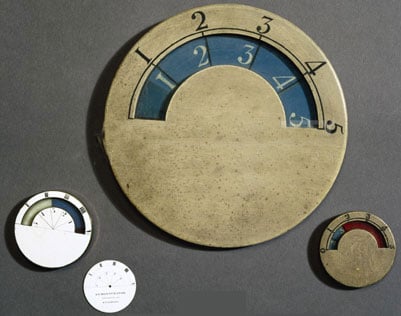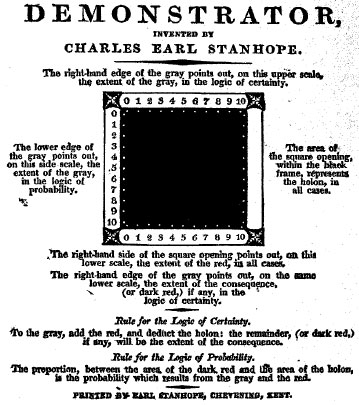
©Unknown author / public domain
Key Points:
- Charles Stanhope created a logic machine he called the Demonstrator, a device able to solve mechanically traditional syllogisms, numerical syllogisms, and elementary probability problems.
- Stanhope was also known for designing 3 mechanical calculator prototypes, two of which were purchased by Charles Babbage.
- The Demonstrator was important because it demonstrated that problems of logic could be solved by mechanical means.
Charles Stanhope
The name of British statesman and versatile scientist Charles Stanhope (1753-1816) (see biography of Charles Stanhope), 3rd Earl Stanhope and Viscount Mahon, was mentioned several times in this site, concerning his mechanical calculators (see calculating machines of Charles Stanhope). Now it is time to pay attention to his pioneering work in the world of logic machines.

Stanhope worked on his logic machines for some 30 years, creating several versions. On the upper image is shown a circular version of his Demonstrator, created in the late 18th century. The most effective version of the device was the rectangular one (see the lower image), created at the beginning of the 19th century.
Stanhope’s Demonstrator is a device able to solve mechanically traditional syllogisms, numerical syllogisms, and elementary probability problems. The rectangular version of the device consists of a brass plate (10x12x2 cm), affixed to a thin mahogany block. On the brass face, along three sides of the window, integer calibrations from zero to ten were marked. In the center there is a depression (4 cm in area and 2.5 cm deep), called the holon. Across the holon 2 slides can be pushed; one, set in a slender mahogany frame, is of red transparent glass and works through an aperture on the right. The other is of wood and is called the gray slider. In working the “Rule for the Logic of Certainty” this slide is passed through an aperture to the left; but in working the “Rule for the Logic of Probability”, it is drawn out and inserted in an aperture at the top, when it works at right angles to the red slide.

To solve a numerical syllogism, for example:
Eight of ten A’s are B’s;
Four of ten A’s are C’s;
Therefore, at least two B’s are C’s.
Stanhope would push the red slide (representing B) eight units across the window (representing A) and the gray slide (representing C) four units from the opposite direction. The two units that the slides overlapped represented the minimum number of B’s that were also C’s.
To solve a probability problem like:
Prob (A) = 1/2;
Prob (B) = 1/5;
Therefore, Prob (A and B) = 1/10.
Stanhope would push the red slide (representing A) from the north side five units (representing five-tenths) and the gray slide from the east two units (representing two-tenths). The portion of the window (5/10 x 2/10 = 1/10) over which the two slides overlapped represents the probability of A and B.
In a similar way, the Demonstrator could be used to solve a traditional syllogism like:
No M is A.
All B is M.
Therefore, No B is A.
The Demonstrator had obvious limitations. It could not be extended to syllogisms involving more than two premises or to probability problems with more than two events (always assumed to be independent of one another). Any of the problems it could handle were solved easily and quickly without the aid of the machine. Stanhope designed his devices for demonstration purposes, as can be seen by the name Demonstrator, not for solving real-life problems. He wrote “As the instrument is so constructed as to assist us in making demonstrations. I have termed it Demonstrator. It is so peculiarly contrived as likewise to exhibit symbolically those proportions or degrees of probability which it is the object of the Logic of Probability to discover“.
Stanhope bases his system on what De Morgan will call later the arithmetical view of the proposition, and this view determines the form of his method of mediate inference and leads to an extension of the common doctrine. He proposed a rule “for discovering consequences in logic”, which is a remarkable anticipation of that given by De Morgan from the numerically definite syllogism.
Nonetheless, Stanhope believed he had made a fundamental invention. The few friends and relatives who received his privately distributed account of the Demonstrator, The Science of Reasoning Clearly Explained Upon New Principles, were advised to remain silent lest “some bastard imitation” precede his intended publication on the subject. This publication never appeared and the Demonstrator remained unknown until the Reverend Robert Harley described it in the Philosophical Transactions in 1879.
The Demonstrator was important mainly because it demonstrated to others, most notably to William Jevons, that problems of logic could be solved by mechanical means.
Let’s see the description of the Demonstrator, given by Robert Harley in his April 1879, article: “The Stanhope Demonstrator: An Instrument for Performing Logical Operations”:
Earl Stanhope’s Demonstrator is much less powerful as a logical instrument than Professor Jevons’ machine, but the former is undoubtedly a distinct anticipation of the latter. It is probably the first attempt ever made to solve logical problems by mechanical methods. Both in his quantification of the predicate and in his solution of problems involving numerically definite propositions, we see the Earl struggling, not unsuccessfully, to escape into some less confined system of logic than that of Aristotle. He shewed little respect for the authority of the ancient logicians. The same reforming zeal which he displayed in politics he exhibited also in the treatment of logic. He brought to the study of the subject a certain independence and originality of thought which led him to examine the foundations of the science for himself. “I intend,” he declared, “to exclude entirely that long catalogue of pedantic words which are now used for the purpose of drawing consequences, and which are, generally speaking, both unintelligible to youth and unfit for men of any age, so far at least as relates to convenient and habitual use. My system of logic will, on the contrary, be found to have the striking advantage of uniting simplicity, perspicuity, utility, and perfect correctness. The science requires to be totally reformed.”
The materials do not enable us to give a complete or systematic account of Stanhope’s views on logic. Even on the working of his Demonstrator we find in his remains no full or formal statement, but only scattered and fragmentary limits, and a very few simple examples. It is possible, therefore, that in the hands of its noble inventor the instrument possessed a range and power somewhat greater than is apparent to us. He attached to it a practical importance; for us it possesses little more than a theoretic or historic interest. “It exhibits the consequences symbolically,” he wrote, “and renders them evident to the mind. By the aid of this instrument the accuracy or inaccuracy of a conclusion is always shewn, and the reason why such consequences must of necessity exist is rendered apparent. As the instrument is so constructed as to assist us in making demonstrations, I have termed it the Demonstrator. It is so peculiarly contrived as likewise to exhibit symbolically those proportions or degrees of probability which it is the object of the Logic of Probability to discover.”
All propositions are reduced by Stanhope to one form, namely, the expression of the identity of two or more things or classes of things. This “method of identification,” as he calls it, is illustrated by numerous examples. For instance, “Hardness belongs to diamonds,” means that ” Some of those things which possess the quality of hardness and all diamonds are identic.” “Some printing presses cannot be worked without great labor,” means that “Some printing-presses are identic with some of those instruments which cannot be worked without great labor.” In these examples we recognize an anticipation of Mr. George Bentham’s four forms of affirmative propositions, forms which were afterwards adopted by Sir William Hamilton.
Stanhope bases his system on what De Morgan calls the arithmetical view of the proposition; and this view determines the form of his method of mediate inference and leads to an extension of the common doctrine. He proposes a rule “for discovering consequences in logic,” which is a remarkable anticipation of that given by De Morgan from the numerically definite syllogism. It is a noteworthy fact that he does not limit the rule to a special form but puts it forth as embodying the fundamental principle of all syllogistic ratiocination.
The Demonstrator consists of a brass plate 4.5 inches long and 4 inches wide, affixed to a thin block of mahogany. In the centre there is a depression 1.5 inches in area and half an inch deep, called the holon. Across the holon two slides can be pushed; one, set in a slender mahogany frame, is of red transparent glass and works through an aperture on the right. The other is of wood, and is called the gray slider. In working the “Rule for the Logic of Certainty” this slide is passed through an aperture to the left; but in working the “Rule for the Logic of Probability,” it is drawn out and inserted in an aperture at the top, when it works at right angles to the red slide. Stanhope devised several other instruments of various sizes and construction; but they are both less simple and less effective. It does not seem possible for the Demonstrator in its present form to solve very complicated questions. It is constructed for problems involving only three logical terms; but additional slides would increase its range and power. To Stanhope belongs the honour, and it is a very high honour, of being the first (probably) to attempt the solution of logical problems by a mechanical method. There may be some difference of opinion as to how far he succeeded, but there can be none as to the ingenuity of the attempt. The contrivances of earlier logicians, especially the circles of Euler, probably prepared the way; but Stanhope did undoubtedly take a very important step in advance when he constructed his Demonstrator. His conversion of all propositions into the form of identities by means of the quantification of the predicate, and the principle of his mechanical method, namely, that the process of mind involved in the ordinary syllogism and that involved in the numerically definite syllogism are essentially the same, must be regarded as distinct contributions to logical science and as remarkable anticipations of recent discoveries.
The image featured at the top of this post is ©Unknown author / public domain

